Table of Contents
- Home
- »
- Content Marketing
- »
- What is content marketing ROI and how is it measured?
-
Anna Louise
- 10 minutes read time
What is content marketing ROI and how is it measured?
- Home
- »
- Content Marketing
- »
- What is content marketing ROI and how is it measured?
What is content marketing ROI and how is it measured?
Table of Contents
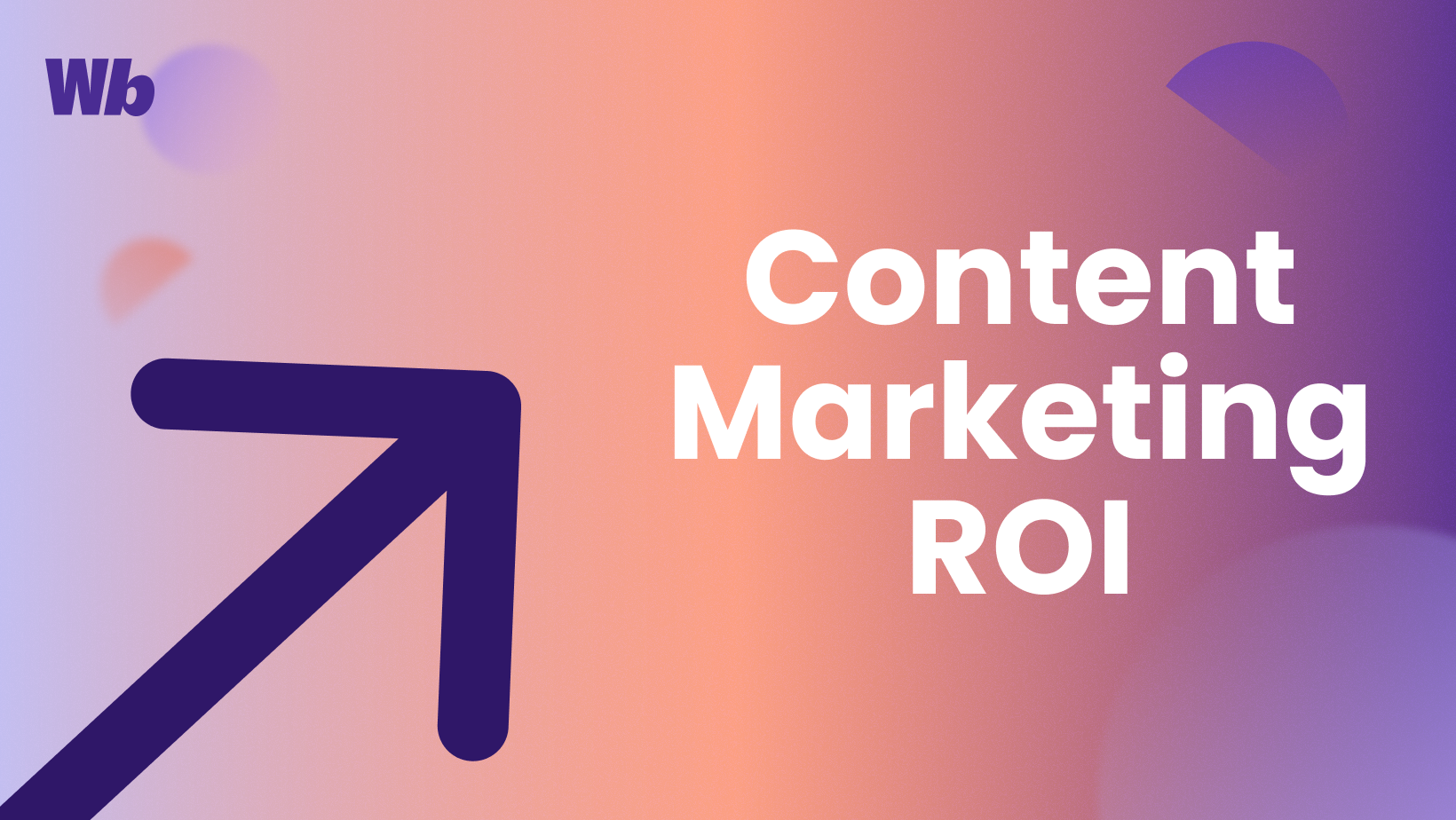
To understand your marketing strategy’s effectiveness, measuring the return on investment (ROI) is crucial.
Measuring the ROI of content marketing requires a formulaic approach, balancing the costs against the returns. Key performance metrics such as sales growth and customer engagement are essential for an accurate assessment.
Continuous review and adjustment of strategies based on ROI calculations enable ongoing refinement and improved outcomes. This article explores the intricacies of calculating content marketing ROI, highlighting key metrics like engagement rates, conversion rates, and lead generation.
We also address the common challenges faced in quantifying content effectiveness and how these measurements influence broader decision-making. Here, we’re also talking about the knowledge and tools necessary to accurately optimize your content marketing initiatives.
TL;DR
- Content marketing ROI is a measure of the financial returns from content marketing, comparing revenue generated against costs incurred.
- The ROI of content marketing is calculated by subtracting content creation and distribution costs from revenue, then dividing by total costs, and multiplying by 100.
- Costs and revenue sources: Costs include content creation, staff, tools, and distribution; revenue comes from direct sales and indirect benefits like brand awareness.
- Importance of accurate ROI measurement: Measuring the ROI of your content marketing efforts helps guide marketing strategy, indicating where to increase or adjust investment.
- Measuring success with KPIs: Track metrics like sales growth, lead generation, and customer engagement to gauge ROI; use tools like Google Analytics and CRM systems.
- Aligning content goals with business objectives: Content marketing should support broader business strategies, focusing on brand awareness, credibility, trust, and education.
- Platform-specific ROI measurement: Use tools like Google Analytics for websites and social media analytics for engagement; track conversions, sales, and lead quality across platforms.
What is content marketing ROI?
Content marketing ROI is a metric used to evaluate the effectiveness of content marketing in terms of financial returns. It is a performance indicator that helps businesses understand the value generated from their content marketing investments relative to the costs incurred.
To calculate content marketing ROI, we subtract the total costs of creating and distributing content from the revenue generated. We then divide this figure by the total costs and multiply by 100 to express it as a percentage. This calculation provides a clear, numerical value that reflects the profitability of content marketing activities.
The costs involved in content marketing include content creation, staff salaries, technology tools, and paid content distribution channels. It’s essential to consider all relevant expenses to get an accurate measure of ROI, and they can vary greatly depending on the size and scale of the marketing campaign.
Measuring the revenue side of things can be more challenging. Revenue can come from direct sales resulting from content marketing, but also from less tangible benefits like increased brand awareness or customer loyalty. These indirect benefits often translate into long-term gains, making them pivotal components of the ROI calculation.
Understanding content marketing ROI is vital for businesses as it guides decision-making in marketing strategies. A positive ROI indicates that the content marketing strategies are paying off, encouraging continued or increased investment in these areas. Conversely, a low or negative ROI suggests a need for reevaluation and adjustment of strategies.
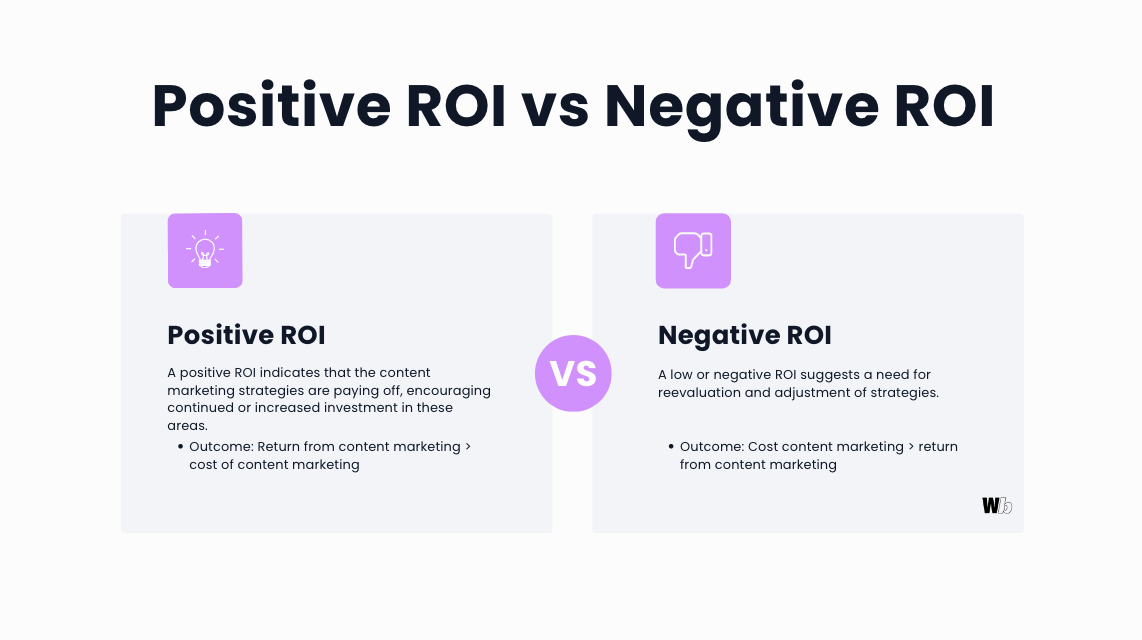
How can you measure the ROI of content marketing?
Measuring the ROI of content marketing involves a clear, structured approach and the use of a succinct formula.
The content marketing ROI formula
ROI = (Return from content marketing – cost of content marketing / Cost of content marketing) x100
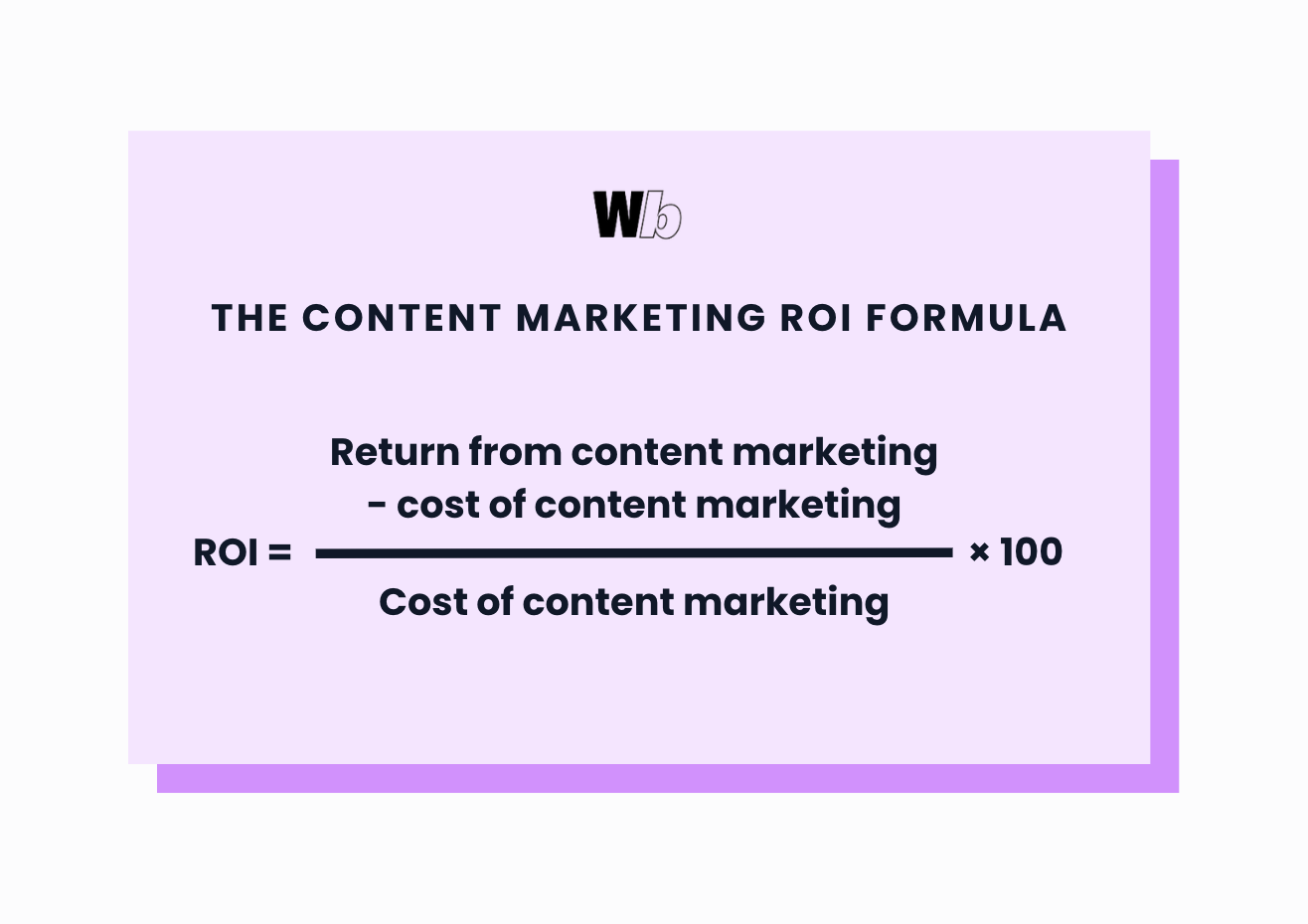
This content marketing ROI formula provides a percentage that shows the efficiency of your content marketing in financial terms.
Let’s take a quick example. Say you want to measure your content marketing ROI for the first half of 2023. Looking back, you notice that you spent $12,000 on content marketing including SEO tools, hiring freelance writers, and distributing your content. If the returns from your content marketing efforts for this time period is $30,000, you can measure your content marketing ROI by plugging the values in the formula as follows:
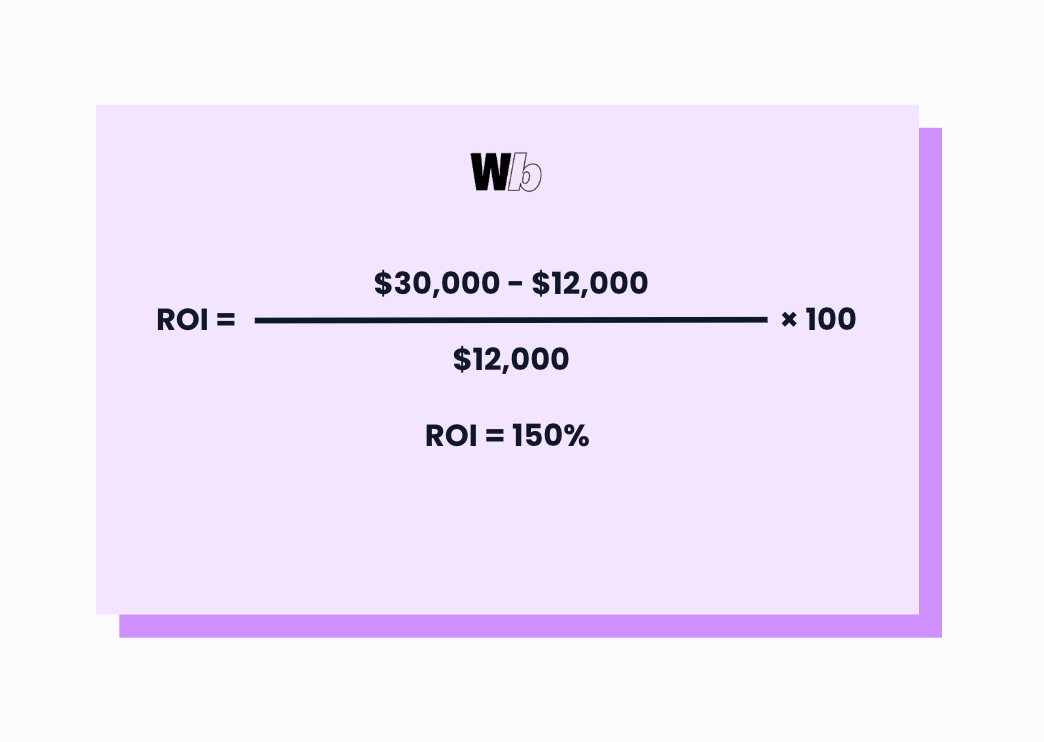
To accurately measure returns, track key metrics such as sales growth, lead generation, and customer engagement directly attributed to content marketing. It’s fundamental to use reliable tools for tracking these metrics, such as website analytics for online traffic or CRM systems for sales data.
The cost side includes expenses like content creation, content distribution, and promotional activities. Remember to account for all costs, including indirect ones like the time spent by your team. By comparing the total costs against the financial gains, you get a clear picture of how much revenue your content marketing generates.
When calculating content marketing ROI, regularly reviewing and adjusting your approach based on these ROI calculations is key. This continuous process helps in refining strategies and achieving better results over time.
Understanding success metrics and setting goals
In content marketing, key performance indicators (KPIs) and metrics are essential for evaluating success and guiding strategy. KPIs are quantifiable measures that help assess the performance of your content marketing against specific objectives.
Common KPIs include website traffic, engagement rates, lead generation, and conversion rates. These indicators provide valuable insights into how effectively your content resonates with your target audience and drives business goals.
It’s important to use actionable metrics here. Unlike vanity metrics, which might look impressive but offer little insight into performance, actionable metrics directly relate to business outcomes. Examples include the number of qualified leads generated, the conversion rate of leads to customers, and the customer acquisition cost. These insights offer a more detailed understanding of how content influences business objectives.
You also need to set clear and specific goals for your content marketing. Goals should be SMART: Specific, Measurable, Achievable, Relevant, and Time-bound. For instance, instead of a vague goal like “increase traffic,” a SMART goal would be “increase traffic from targeted demographics by 20% over the next quarter.” This specificity allows for more effective planning and evaluation.
Finally, aligning content marketing goals with overall business objectives is vital. Content marketing should not exist in a silo; instead, it should support and enhance wider business strategies. For example, if a prime business objective is to enter a new market, content marketing should focus on building brand awareness and establishing thought leadership within that market.
By aligning content marketing goals with business objectives, you guarantee that your efforts contribute to the overall growth and success of the organization.
In summary, understanding and effectively using KPIs and actionable metrics, setting clear and specific goals, distinguishing content marketing from other forms of marketing, and aligning these efforts with business objectives are necessary steps in measuring and maximizing the success of content marketing initiatives.
Which KPIs and metrics should you choose to measure content marketing success?
Choosing the right KPIs and metrics is vital for accurate analysis when measuring content marketing success. Here’s a detailed list of important KPIs and metrics, along with how they are measured and their significance:
Website traffic
This metric measures the number of visitors to your website. It’s crucial for understanding the overall reach and appeal of your content. Tools like Google Analytics are invaluable for measuring website ROI. They track metrics such as page views, user behavior, and conversion rates.
By analyzing this data, you can understand how well your content attracts and retains visitors, and how effectively it drives them to take desired actions.
Engagement rate
This includes metrics such as time spent on a page, pages per session, and bounce rate. High engagement rates often indicate that your content is resonating with your audience. These metrics can be tracked using web analytics tools and help you understand the quality of visitor interactions with your content.
Read more: 15 content engagement metrics every team should know
Number of leads
This KPI tracks the number of leads generated through content marketing. It involves monitoring actions like form submissions, newsletter sign-ups, and downloads of gated content. CRM systems are typically used to measure this, helping you understand how effective your content is at moving visitors through the sales funnel.
Conversion rate
This measures the percentage of visitors who take a desired action, such as making a purchase. A high conversion rate suggests that your content is effective in encouraging visitors to engage in a meaningful way with your brand.
Social shares and likes
Social media content is key for building brand trust and awareness. Keep track of shares, likes, and comments—these metrics indicate the popularity and shareability of your content, offering insights into its reach and impact on social media.
SEO performance
Metrics like keyword rankings, organic search traffic, and backlinks are important for assessing how well your content performs in search engines. Tools like SEMrush or Ahrefs can be used to track these metrics, helping you understand how well your content is optimized for search and its visibility online.
Customer retention rate
This measures how effectively content marketing contributes to retaining customers. It involves tracking repeat purchases or renewals and can be indicative of customer satisfaction and loyalty.
Return on investment (ROI)
Ultimately, calculating the ROI of your content marketing methods is critical. This involves assessing how much revenue is generated from content marketing relative to its costs. A positive ROI indicates success with your marketing budget.
Each of these KPIs and metrics offers a different perspective on the performance of your content marketing, allowing you to build a comprehensive understanding of its effectiveness. By carefully selecting and analyzing these KPIs, you can refine your content strategy to better meet your business goals and audience needs.
Refining content marketing strategy based on ROI
A dynamic content marketing strategy must prioritize ROI while maintaining core goals like brand awareness, credibility, trust, and education. This requires not only calibrating with overall business objectives but also leveraging data-driven insights to optimize spending and impact.
Brand awareness: Prioritize creating and amplifying content that has demonstrated the highest engagement and brand visibility. Invest more in content forms, like blog posts, if they prove to be the most effective in reaching and expanding your target audience.
Credibility and trust: Allocate resources to content types that have successfully established your brand’s authority. If certain formats or topics have consistently built trust with your audience, focus your efforts and budget there.
Education: Direct spending towards educational content that has shown tangible value in informing and engaging your audience. Identify which formats—blogs, videos, infographics—best educate your customers about your products and services, and scale these efforts.
Lead generation and sales: Adapt your strategy to emphasize content that effectively guides potential customers through the sales funnel. Analyze which content types have been most successful in addressing customer pain points, highlighting product benefits, and driving conversions, and then increase investment in these areas.
Analytics and attribution: Heavily invest in multi-touch attribution models and analytics expertise. This will enable a deeper understanding of the customer journey and the specific role different content types play in conversions and sales. Use these insights to continually refine your content strategy, focusing on what delivers the best ROI.
Redefine your content marketing strategy by using ROI as a guiding principle. Continuously analyze and adjust your approach to ensure that investment in content creation and distribution is both strategic and effective, directly contributing to your business goals.
Advanced measurement and strategy adjustments
Advanced measurement techniques and strategic adjustments are required to achieve optimal ROI in a competitive content marketing landscape.
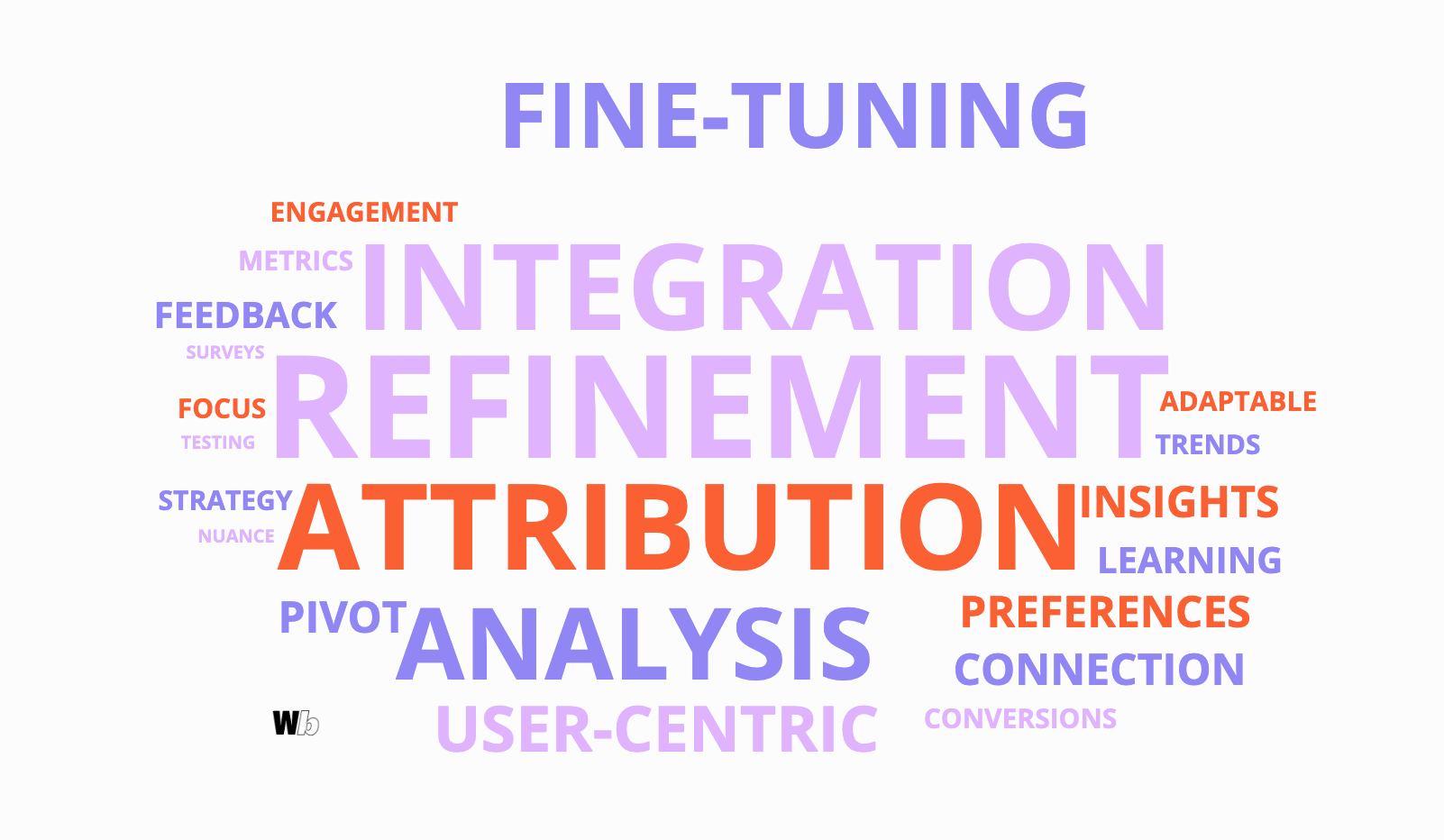
- Developing advanced attribution models: Implementing sophisticated attribution models, such as multi-touch attribution, provides a more nuanced understanding of how different content types contribute to the customer journey and final conversions. These models help in allocating marketing resources more effectively and in fine-tuning content strategies for better outcomes.
- Pivoting strategies: Be adaptable. If certain content types or strategies are not yielding the expected ROI, it’s necessary to pivot. This might involve shifting focus to general marketing content that addresses wider audience needs or exploring new content formats and distribution channels.
- Utilizing various metrics for comprehensive analysis: A well-rounded content marketing strategy employs a range of metrics for analysis. Consumption metrics (like page views and time spent on content), sales metrics (such as conversion rates), lead quality assessments (evaluating the potential of leads to convert), and SEO metrics (tracking keyword rankings and organic traffic) all play roles in measuring the effectiveness of a content marketing campaign.
- Continuous strategy refinement: The insights gained from these advanced measurements should inform ongoing strategy adjustments. This process involves continuously testing, learning, and refining approaches to ensure that content marketing methods align with evolving market trends and consumer preferences.
- Integrating customer feedback for enhanced engagement: Actively incorporate customer feedback into content strategy. This involves using surveys, social media interactions, and user comments to understand audience needs and preferences. Through this method, strategies become more user-centric, fostering increased engagement and a stronger connection.
If content marketers embrace advanced measurement techniques and remain flexible in strategy, they can make sure that their efforts are effective, agile, and highly adaptable.
Measure content marketing ROI through traffic monetization
In content marketing, two prevalent business models are Direct Traffic Monetization and Traffic Conversion Monetization. Direct Traffic Monetization refers to businesses where income is directly linked to the amount of traffic, typically seen in advertising models.
Conversely, Traffic Conversion Monetization involves businesses that need to transform their traffic into leads or customers. For these businesses, revenue is not directly proportional to traffic volume.
For B2B companies, it’s essential to comprehend how traffic translates into leads and the effectiveness of converting these leads into customers. This understanding aids in calculating ROI using the average contract value (ACV).
E-commerce sites, however, determine the value of their traffic and calculate ROI using their conversion rate and average order value (AOV). This approach helps in understanding the direct financial impact of content marketing on different business models.
Tracking conversions and sales
Conversions and sales are direct indicators of ROI. On your website, conversion tracking can be set up to measure actions like form submissions, product purchases, or sign-ups. In social media, tracking tools can link specific posts to conversions or sales, helping you understand the direct financial impact of your content.
Lead quality
Assessing the quality of leads generated by your content marketing is vital because high-quality leads are more likely to convert into customers. Tools like CRM software can help track lead sources and the progression of leads through the sales funnel.
Engagement metrics on social media
Engagement metrics on social media platforms provide insights into how well your content resonates with your audience. High engagement rates typically correlate with higher brand loyalty and trust.
Platform-specific ROI calculation
Each platform requires a specific approach to ROI calculation. For instance, the ROI of social media content can be calculated by assessing the value of increased brand awareness and the number of leads generated through these platforms.
Integration of platform data
Integrating data from various platforms provides a holistic view of your content marketing ROI. This integrated analysis helps in understanding how different platforms contribute to overall marketing goals and where to allocate resources for maximum impact.
Measuring ROI across different platforms involves a combination of platform-specific tools and metrics. By understanding and leveraging these tools, content marketers can gain comprehensive insights into the effectiveness of their strategies across the web and social media.
Key takeaways for measuring content marketing ROI
In conclusion, measuring the ROI of content marketing is a multifaceted process that requires a strategic approach. By understanding and implementing the right KPIs and metrics, using the correct content marketing ROI formula, redefining content strategies to align with business goals, and utilizing advanced measurement techniques, businesses can not only gauge but also enhance the effectiveness of their content marketing campaign.
Your business should ensure that every piece of content contributes to the organization’s broader objectives. With this comprehensive approach, you’re better positioned to make informed decisions, maximize your content marketing investment, and achieve sustained success in your marketing endeavors.
Wordbrew’s hybrid content creation platform can help you achieve this fine balance—contact us today to find out how we can level up your business.